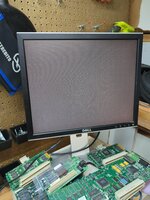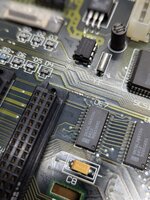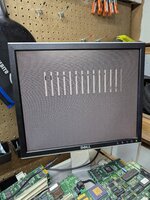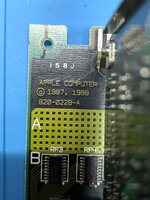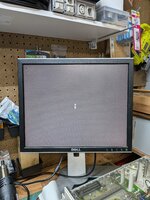Congrats on your success
@DevyDevly!
I was working on my board last night, I ended up replacing every 74ALS651 with chips from a Mac II with working video and no change, so that doesn’t appear to be the root issue. I measured some of the replacement caps and noticed they were under voltage, some were 5V others were less than 1V. I guess I didn’t do a great job with those connections? I reflowed all the capacitors and re-measured and they all measure 5V now, with two (I think?) of the axials measuring 12V. After I reflowed the capacitors it did, for a second, have a slight change in behavior, there were no vertical bars and I could see the whole mouse. I didnt have a mouse attached so I couldn’t check how it looked if I moved it. The Missing Disk icon was still only partially showing. Unfortunately, after a reboot, it reverted to showing the vertical bars with missing video data.
I’ve also swapped the CPU, FPU, 68851 and all the ROM chips with the board that works just to rule any of those out.
Thanks
@blturner 
I'm quite chuffed.
If I had to bet on your issue I'd bet on
another broken trace - to quote Wall Street Pros when reviewing a bad quarter "where there's one turd, there's many".
And trying to follow traces on the top side, under chips and slots, can be quite tricky. I found the Bomarc
Mac II schematics very useful to identify what is going where (even though I'm still confused by parts of the schematics - but I'm not a Wizard either).
RE: Cap voltages. Remember those caps near the burn in edge connector are negative voltages, so measure the other side.
The two
traces I fixed on my board were quite a long way from each other. But, my board is in quite bad shape so I'm surprised there was only two to fix.
I didn't mention that I had to stop using my
820-0198 video cards - I have two of them and neither would give me a prompt or good picture on my Dell 2405FPW monitor (or my other Samsung backup monitor). Either of those monitors (with 10pin adapter) handle my other vintage Macs and cards without issue (IIci, IIcx, Quada 700). But the 820-0198 just doesn't want to play nice.
Switching to a 820-0600 card helped sort my picture problems. I discovered this because I have a Rev A Macintosh II as well - it was an easy ROM fix but while fixing it I disovered the modern monitor/820-0198 issues.
Onto my next issue now...
removing a LOT of rust from the internal frame and shielding.
GLUCK!
PS Here's what I started with... crimes were committed against this machine...

